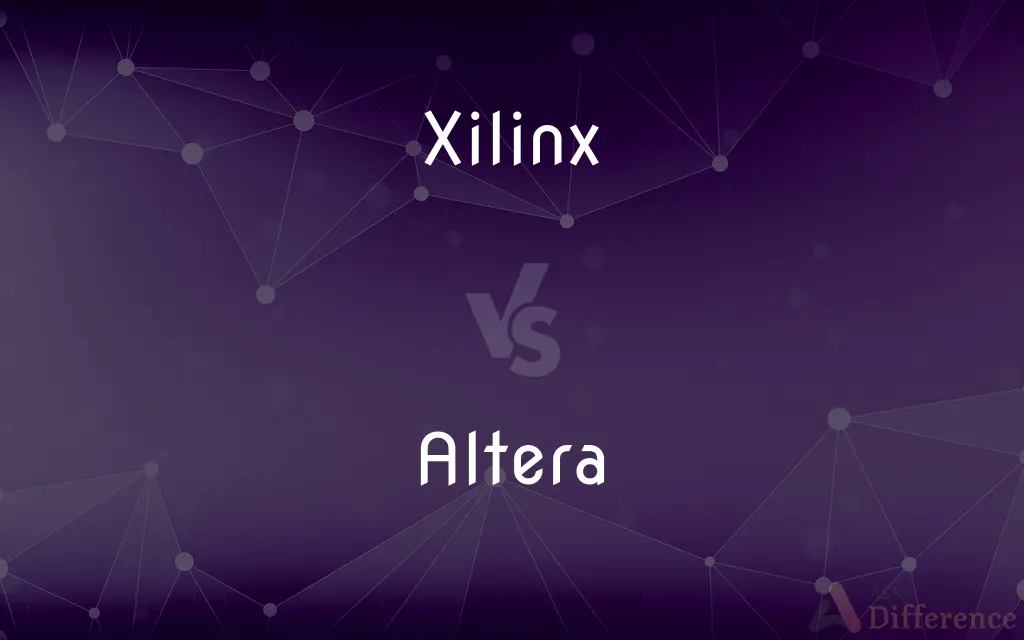Xilinx vs. Altera — What's the Difference?
By Tayyaba Rehman & Urooj Arif — Updated on May 7, 2024
Xilinx primarily led FPGA innovation and market share, focusing on advanced technologies like the Versal series; Altera, now part of Intel, emphasizes integration with Intel's technologies and broad applications.

Difference Between Xilinx and Altera
Table of Contents
ADVERTISEMENT
Key Differences
Xilinx has historically been a pioneer in the field of Field Programmable Gate Arrays (FPGAs), often leading in technological advancements and market presence. In contrast, Altera, which was acquired by Intel in 2015, has been able to leverage Intel's extensive technological ecosystem to enhance its FPGA capabilities.
While Xilinx developed the first FPGA and continues to innovate with products like the Versal series, which are designed for adaptable computing, Altera has focused on creating FPGAs that are optimized to work seamlessly with Intel's CPUs and software, providing a more integrated system approach.
On the other hand, Xilinx has a strong emphasis on AI and data center applications, aiming to push the boundaries of FPGA use in these high-growth areas. Whereas Altera benefits from Intel’s manufacturing capabilities, potentially giving it an edge in producing more cost-effective and power-efficient FPGA solutions.
Xilinx also tends to cater to a wide range of industries including aerospace, automotive, and telecommunications with its highly customizable solutions. Altera, however, often focuses on integrating its products with Intel's solutions, targeting similar industries but with a potentially different approach to market needs.
In terms of software tools, Xilinx offers the Vivado Design Suite, which provides a sophisticated environment for FPGA programming. Meanwhile, Altera’s Quartus Prime software aligns closely with Intel’s technology stack, offering unique features like oneAPI for cross-platform programming.
ADVERTISEMENT
Comparison Chart
Ownership
Independent company until AMD acquisition
Acquired by Intel in 2015
Key Products
Versal, Spartan, Zynq
Stratix, Arria, Cyclone
Software
Vivado Design Suite
Quartus Prime
Industry Focus
Broad (auto, telecom, aerospace)
Integrated with Intel’s tech (similar industries)
Technological Edge
Advanced AI and data center applications
Integration with Intel CPUs and software
Compare with Definitions
Xilinx
Versal Series.
Xilinx's Versal series is tailored for adaptive computing across various applications.
Altera
FPGA Manufacturer.
Altera has been known for its high-performance FPGAs before being acquired by Intel.
Xilinx
Market Leader.
Xilinx has often led the market in terms of FPGA innovation and adoption.
Altera
Quartus Prime.
Altera offers Quartus Prime, focusing on FPGA design with enhanced software integration.
Xilinx
FPGA Manufacturer.
Xilinx was the first company to develop and market FPGA technology.
Altera
Part of Intel.
As part of Intel, Altera FPGAs are optimized for integration with Intel technologies.
Xilinx
Vivado Design Suite.
Xilinx offers the Vivado Design Suite for advanced FPGA programming.
Altera
Stratix Series.
Altera’s Stratix series is known for its high performance and configurability.
Xilinx
Adaptive Computing.
Xilinx focuses on adaptive computing to cater to AI and data center demands.
Altera
System-on-Chip (SoC) FPGAs.
Altera develops SoC FPGAs that combine the power of FPGAs with ARM processors.
Xilinx
Xilinx, Inc. ( ZY-links) was an American technology and semiconductor company that primarily supplied programmable logic devices.
Altera
Altera Corporation was a manufacturer of programmable logic devices (PLDs) headquartered in San Jose, California. It was founded in 1983 and acquired by Intel in 2015.
Common Curiosities
What is FPGA?
FPGA stands for Field Programmable Gate Array, a type of digital integrated circuit that can be programmed after manufacturing.
When did Intel acquire Altera?
Intel acquired Altera in December 2015.
What are the key differences in the FPGA products offered by Xilinx and Altera?
Xilinx products tend to focus on technological leadership and versatility, whereas Altera’s products, under Intel, emphasize cost-effectiveness and integration with Intel's other technologies.
Can Xilinx FPGAs be used in consumer electronics?
Yes, Xilinx FPGAs are used in various consumer electronics for functions like signal processing and video encoding.
What industries does Altera primarily serve?
Altera serves industries like telecommunications, computing, and industrial applications.
Who founded Xilinx?
Xilinx was founded by Ross Freeman, Bernard Vonderschmitt, and James V Barnett II in 1984.
How does the cost of FPGAs from Xilinx and Altera compare?
Costs can vary significantly based on the specific needs and scales of projects, though Altera might benefit from potentially lower manufacturing costs due to Intel's resources.
Which software is used for designing circuits with Xilinx FPGAs?
Vivado Design Suite is used for designing circuits on Xilinx FPGAs.
How do the FPGA architectures of Xilinx and Altera differ?
Xilinx often adopts more cutting-edge architectural innovations, while Altera’s designs tend to emphasize integration and efficiency, supported by Intel’s technology.
How does Altera's integration with Intel affect its FPGA designs?
This integration allows Altera to optimize its FPGAs for better compatibility and performance with Intel’s processors and software.
Which Xilinx product is geared towards AI applications?
The Versal series is specifically designed for AI and machine learning applications.
What makes Xilinx FPGAs unique in the market?
Xilinx's focus on adaptive computing and AI applications sets its FPGAs apart in the market.
Can Altera FPGAs be used in automotive applications?
Yes, Altera FPGAs are suitable for automotive applications, especially in areas like autonomous driving and infotainment systems.
What future developments are expected from Xilinx and Altera?
Both companies are expected to continue evolving their FPGA technologies with a focus on energy efficiency, performance, and integration with broader technology platforms.
What is the advantage of Altera being part of Intel?
Being part of Intel provides Altera with access to advanced manufacturing processes and a broad technology ecosystem.
Share Your Discovery

Previous Comparison
Conner vs. Corner
Next Comparison
Sketch vs. PictureAuthor Spotlight
Written by
Tayyaba RehmanTayyaba Rehman is a distinguished writer, currently serving as a primary contributor to askdifference.com. As a researcher in semantics and etymology, Tayyaba's passion for the complexity of languages and their distinctions has found a perfect home on the platform. Tayyaba delves into the intricacies of language, distinguishing between commonly confused words and phrases, thereby providing clarity for readers worldwide.
Co-written by
Urooj ArifUrooj is a skilled content writer at Ask Difference, known for her exceptional ability to simplify complex topics into engaging and informative content. With a passion for research and a flair for clear, concise writing, she consistently delivers articles that resonate with our diverse audience.
















































